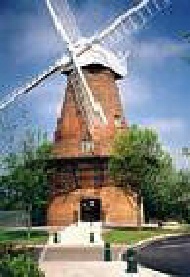

RCC TREASURE HUNT #3
We’ll start where we finished in Sudbury and concentrate on Quay Lane off Friar Street. At the end is the car park for the businesses there. Again I say – this is not a race-
Q 1 What was The Quay building before its present function?
Q2 Who was appointed as Fundraiser for Quay2000
During the digging of this cut,
Q3 What was found belonging to a large animal, parts of which are in the possession of a butcher in Long Melford?
The cut here was dug before the 1795 canalisation of the Stour (The Stort was canalised in 1796 and the Chelmer in 1797) had 15 locks and the towpath crossed the river 33 times. The barges were drawn by two horses going upstream and by one horse going down; the journey took 14 hours upstream and 12 hours down. The horses were trained to jump on and off the barges to be ferried across the river when the towpath changed sides. They had also, in the early days of the Navigation, to jump stiles between fields as shown in Constable's picture "The Leaping Horse". Later the stiles were replaced by gates.
Continuing to travel downstream till we arrive at The Henny Swan as noted in our last escapade! This sits between 2 churches on a NE & SW direction. Little Cornard church was visited by Martin Shaw who wrote a well known hymn.
Q4 What was it?
To the SW is another church with a rather unusual font –
Q5 What shape is it?
Continuing south on Henny Street this time we arrive at Lamarsh village. Its church is very unusual for both its name and another significant feature.
Q6 How many other churches in England have the same name?
The 14thC pub is now run by the community
Q7 What is its nickname
Continuing south on Bell Hill we soon arrive at the town of Bures crossing the Stour back into Suffolk. So Bures straddles 2 counties, Bures Hamlet in Essex and Bures St. Mary in Suffolk.
Q8 According to the twelfth-
Q9 What is the weight of the heaviest bell in the church
Take a Street view ‘journey’ up the B1508 into the High Street to see some old 16thC buildings. Turning left into the High Street you will see on the right H C Chambers which started in 1877 with horse and carts as hauliers and growing into a large bus company-
Q10 A resident here commissioned a picture by her nephew John Constable – where is it?
The Anchor Hotel near Bell Bridge was often a night stopover for the barges.
Q11 Why is it called Bell Bridge?
Using Street View the blue building next door, #24, has a name and a circa date.
Q12 What is the name and the date?
Following the river to the east we find the river being crossed by the road at Weir Road at Boxted Bridge.
Q13 The original bridge for pedestrian at Boxted Mill was rebuilt -
Following the river it is joined in a few places by the River Box,
Q14 How long is it?
Q15 Where is the source?
Rather than follow the meandering river we’ll take the B1115 in NE direction till we join Powney Road going SSE till we cross the river again. Here is another village made wealthy in the woollen era with several merchants having their own currency in the town as it then was.
Q16 What were these coins called?
There were 22 maltings at one time and many pubs – few survived! One of which was the White Hart.
Q17 A son of the landlady was famous for his wild pet and the attraction he built in the backyard. What was his name and his attraction?
We’ll leave the village towards the SE onto the A1071 and then turning southwards at Calais Street to Polstead. It’s name is derived from the ponds, but in the 19thC it was famous for its orchard on Polstead Heath.
Q18 What fruit was grown/harvested there?
Continuing on Water Lane we turn right at the T junction into Mill Street then crossing the Box to arrive in Stoke-
Q19 In which year did he paint it?
The village has a close connection to Rayleigh through a person who owned the village in 1086!
Q20 Who was that?
So we’ll leave here on Park Street the B1068 going SE till we cross the River Box again at Thorrington Street which will eventually take us to The River Stour again!
We have visited many locations of Lovejoy https://www.google.com/maps/d/viewer?mid=1ghT7iIp1KeKfVg54y5qGbzdoz2Q&ll=51.968699134948594%2C0.735360587644891&z=11 & https://www.imdb.com/title/tt0090477/locations and passed several churches to St Mary!
Next time we’ll start at the River Brett and take in some more historic and picturesque locations and hopefully learn a bit more about our beautiful area – all within a couple of hours driving! Maybe when the lockdown is over you’ll be tempted to explore a bit more – otherwise just explore Google Maps and enjoy the photos.
QUIZ 8
| 2 Menu Main |
| 3 Menu Dessert |
| 4 Basket Meals |
| 5 Function Menu |
| Google Guide 2 |
| Google Guide 3 |
| Links - Ford |
| Links |
| PC Page 2 |
| PC Page 3 |
| PC Page 4 |
| PC Page 5 |
| 3 Charity Donations |